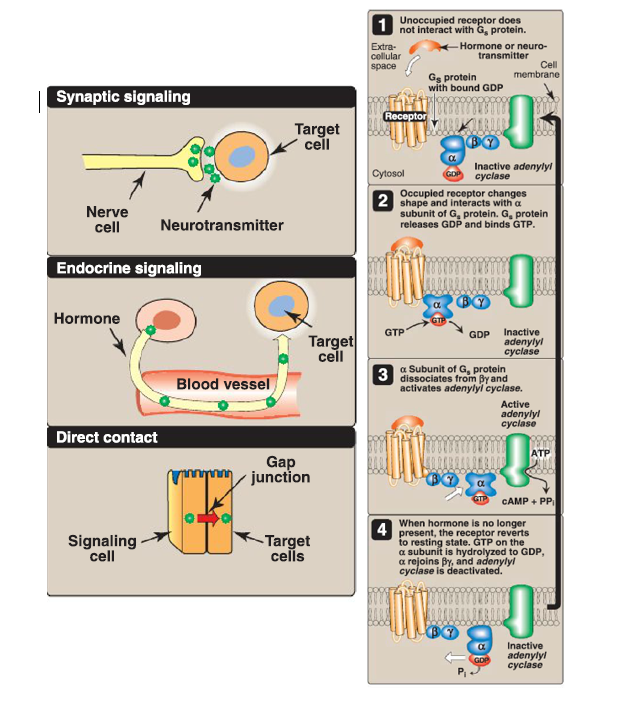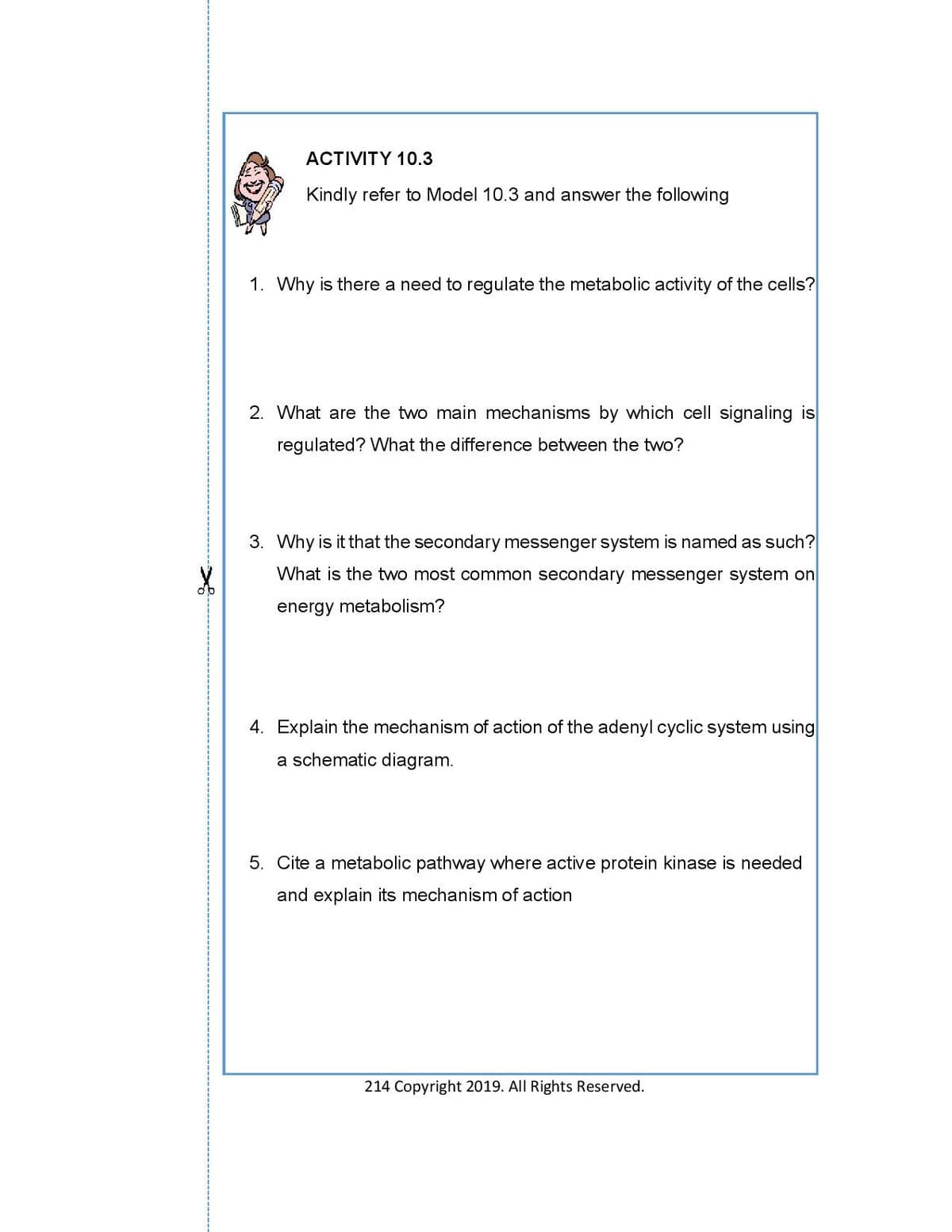1 Unoccupied receptor does not interact with G, protein. Extra- collular space -Hormone or neuro- transmitter Cell membrane Gs protein with bound GDP Synaptic signaling Receptor Target cell Inactive adenylyl Cytosol GOP cyclase Nerve cell Occupied receptor changes 2 shape and interacts with a subunit of G, protein. G, protein releases GDP and binds GTP. Neurotransmitter Endocrine signaling Hormone Inactive adenylyl cyclase GTP Target cell GDP a Subunit of G, protein 3 dissociates from By and Blood vessel activates adenylyl cyclase. Active adenylyl cyclase Direct contact АТР Gap junction GTP CAMP + PP When hormone is no longer 4 present, the receptor reverts to resting state. GTP on the a subunít is hydrolyzed to GDP, a rejoins By, and adenylyl cyclase is deactivated. Signaling cell Target cells Inactive adenylyl cyclase ACTIVITY 10.3 Kindly refer to Model 10.3 and answer the following 1. Why is there a need to regulate the metabolic activity of the cells? 2. What are the two main mechanisms by which cell signaling is regulated? What the difference between the two? 3. Why is it that the secondary messenger system is named as such? What is the two most common secondary messenger system on energy metabolism? 4. Explain the mechanism of action of the adenyl cyclic system using a schematic diagram. 5. Cite a metabolic pathway where active protein kinase is needed and explain its mechanism of action 214 Copyright 2019. All Rights Reserved.
1 Unoccupied receptor does not interact with G, protein. Extra- collular space -Hormone or neuro- transmitter Cell membrane Gs protein with bound GDP Synaptic signaling Receptor Target cell Inactive adenylyl Cytosol GOP cyclase Nerve cell Occupied receptor changes 2 shape and interacts with a subunit of G, protein. G, protein releases GDP and binds GTP. Neurotransmitter Endocrine signaling Hormone Inactive adenylyl cyclase GTP Target cell GDP a Subunit of G, protein 3 dissociates from By and Blood vessel activates adenylyl cyclase. Active adenylyl cyclase Direct contact АТР Gap junction GTP CAMP + PP When hormone is no longer 4 present, the receptor reverts to resting state. GTP on the a subunít is hydrolyzed to GDP, a rejoins By, and adenylyl cyclase is deactivated. Signaling cell Target cells Inactive adenylyl cyclase ACTIVITY 10.3 Kindly refer to Model 10.3 and answer the following 1. Why is there a need to regulate the metabolic activity of the cells? 2. What are the two main mechanisms by which cell signaling is regulated? What the difference between the two? 3. Why is it that the secondary messenger system is named as such? What is the two most common secondary messenger system on energy metabolism? 4. Explain the mechanism of action of the adenyl cyclic system using a schematic diagram. 5. Cite a metabolic pathway where active protein kinase is needed and explain its mechanism of action 214 Copyright 2019. All Rights Reserved.
Biochemistry
6th Edition
ISBN:9781305577206
Author:Reginald H. Garrett, Charles M. Grisham
Publisher:Reginald H. Garrett, Charles M. Grisham
Chapter32: The Reception And Transmission Of Extracellular Information
Section: Chapter Questions
Problem 20P
Related questions
Question
Answer for Number 2 question. Thank you. no need for a long explanation.

Transcribed Image Text:1 Unoccupied receptor does
not interact with G, protein.
Extra-
collular
space
-Hormone or neuro-
transmitter
Cell
membrane
Gs protein
with bound GDP
Synaptic signaling
Receptor
Target
cell
Inactive adenylyl
Cytosol
GOP
cyclase
Nerve
cell
Occupied receptor changes
2 shape and interacts with a
subunit of G, protein. G, protein
releases GDP and binds GTP.
Neurotransmitter
Endocrine signaling
Hormone
Inactive
adenylyl
cyclase
GTP
Target
cell
GDP
a Subunit of G, protein
3 dissociates from By and
Blood vessel
activates adenylyl cyclase.
Active
adenylyl
cyclase
Direct contact
АТР
Gap
junction
GTP
CAMP + PP
When hormone is no longer
4 present, the receptor reverts
to resting state. GTP on the
a subunít is hydrolyzed to GDP,
a rejoins By, and adenylyl
cyclase is deactivated.
Signaling
cell
Target
cells
Inactive
adenylyl
cyclase

Transcribed Image Text:ACTIVITY 10.3
Kindly refer to Model 10.3 and answer the following
1. Why is there a need to regulate the metabolic activity of the cells?
2. What are the two main mechanisms by which cell signaling is
regulated? What the difference between the two?
3. Why is it that the secondary messenger system is named as such?
What is the two most common secondary messenger system on
energy metabolism?
4. Explain the mechanism of action of the adenyl cyclic system using
a schematic diagram.
5. Cite a metabolic pathway where active protein kinase is needed
and explain its mechanism of action
214 Copyright 2019. All Rights Reserved.
Expert Solution
This question has been solved!
Explore an expertly crafted, step-by-step solution for a thorough understanding of key concepts.
Step by step
Solved in 4 steps

Recommended textbooks for you

Biochemistry
Biochemistry
ISBN:
9781305577206
Author:
Reginald H. Garrett, Charles M. Grisham
Publisher:
Cengage Learning

Biology 2e
Biology
ISBN:
9781947172517
Author:
Matthew Douglas, Jung Choi, Mary Ann Clark
Publisher:
OpenStax

Biology: The Dynamic Science (MindTap Course List)
Biology
ISBN:
9781305389892
Author:
Peter J. Russell, Paul E. Hertz, Beverly McMillan
Publisher:
Cengage Learning

Biochemistry
Biochemistry
ISBN:
9781305577206
Author:
Reginald H. Garrett, Charles M. Grisham
Publisher:
Cengage Learning

Biology 2e
Biology
ISBN:
9781947172517
Author:
Matthew Douglas, Jung Choi, Mary Ann Clark
Publisher:
OpenStax

Biology: The Dynamic Science (MindTap Course List)
Biology
ISBN:
9781305389892
Author:
Peter J. Russell, Paul E. Hertz, Beverly McMillan
Publisher:
Cengage Learning
